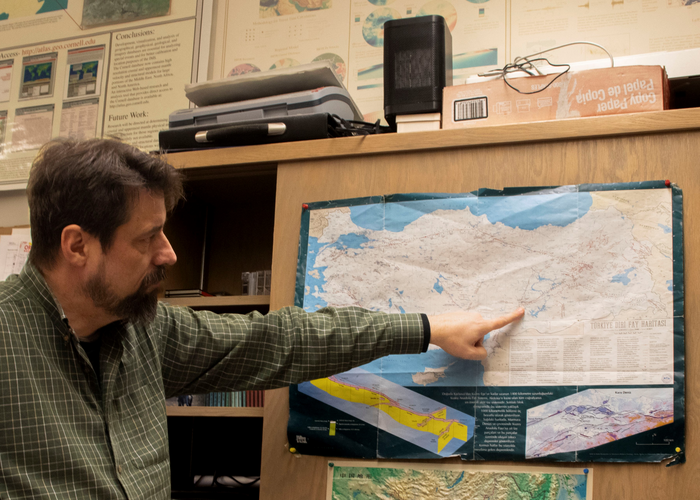COLUMBIA, Mo. — In February, the countries of Turkey and Syria were devastated by a pair of high-magnitude earthquakes occurring nine hours apart. The two events, 7.8- and 7.5-magnitudes respectively, caused thousands of deaths and widespread destruction of infrastructure. Both occurred along the East Anatolian fault, one of Turkey’s two main earthquake zones and a boundary between two of Earth’s tectonic plates, the Arabian Plate and the Anatolian Plate.

Credit: Pate McCuien/University of Missouri
COLUMBIA, Mo. — In February, the countries of Turkey and Syria were devastated by a pair of high-magnitude earthquakes occurring nine hours apart. The two events, 7.8- and 7.5-magnitudes respectively, caused thousands of deaths and widespread destruction of infrastructure. Both occurred along the East Anatolian fault, one of Turkey’s two main earthquake zones and a boundary between two of Earth’s tectonic plates, the Arabian Plate and the Anatolian Plate.
Most of Turkey is considered an active earthquake zone due to the near-constant energy created beneath the ground by these tectonic plates crashing into one another. Eric Sandvol at the University of Missouri and a team of scientists from Georgia Tech and the Scientific and Technological Research Institution of Turkey (TUBITAK) are working to better understand the makeup of the earthquake zone and surrounding areas to help scientists better explain why February’s earthquakes were unusually intense.
“This is what’s called a strike-slip fault, and these earthquakes were big for this type of fault when compared to subduction zones, which produce the biggest earthquakes,” said Sandvol, a professor of geological sciences. “Over the past 200 years, there’s only been one other earthquake — in 1939 — that was as big as this across the entire Mediterranean basin. Another thing that was odd about these earthquakes was energy continued around a bend in the fault zone into a part of Turkey that borders Syria called Hatay, which is one of the locations most devastated by this earthquake. However, when an earthquake encounters a bend that’s typically where the shaking stops.”
Supported by a rapid response grant from the National Science Foundation, the team plans to place 250 seismometers called nodes — an autonomous, wireless sensor approximately the size of a soda can — in and around the area of the East Anatolian fault sometime in late April 2023.
“These sensors record ground motion, and we’re trying to study the properties of the energy waves produced by these earthquakes,” he said. “That’s because different wave properties can tell us a lot about what’s below the ground and the physical structure of the Earth — not only where these earthquakes physically happen but also the greater region itself. For instance, we want to determine if the depth of an earthquake can tell us about its potential magnitude.”
Although the project will focus specifically on the physics of an aftershock, Sandvol believes February’s earthquakes are more representative of what seismologists call a doublet.
“This is where the first earthquake loads another part of the fault and triggers the second earthquake,” he said. “In this case they occurred nine hours apart, but days, months or even years can pass before the second event happens. In fact, along a fault zone just north of this location called the North Anatolian fault, one of the most famous sequences of earthquakes progressed over a period of 60 years from about 1939 to 1999.”
The nodes, developed by SmartSolo Inc., are a newer type of technology to study earthquakes that were adapted from their original use of aiding natural gas and oil exploration. SmartSolo Inc. will be donating 150 of the nodes used in the project, Sandvol said.
“Over the past 10 years, earthquake seismologists have been using this technology to image the natural properties of the Earth’s subsurface,” he said. “But this technology has not been applied before in this way to collect data on the structure of the Earth during aftershocks.”
Unlike other earthquake instruments Sandvol has placed around the world during his career, these nodes are buried in the ground and do not need temporary cement structures called seismic stations.
-30-
Editor’s Note: From a young age, Eric Sandvol has been fascinated with how mountain ranges are formed. Growing up in Denver, Colorado, Sandvol remembers asking his father to frequently stop at old mines scattered throughout the Rocky Mountains so he could collect shiny-looking rocks like pyrite. Since then, he’s built an extensive rock collection by gathering rocks from mountain ranges he’s visited over his career, including the Andes, Caucasus and Himalayas. By combining his passion for collecting rocks with a knack for solving problems using the science of physics, Sandvol, over more than two decades, has used physics to study the Earth — with a specific focus on mountain ranges, or what he calls “mountain belts.”




